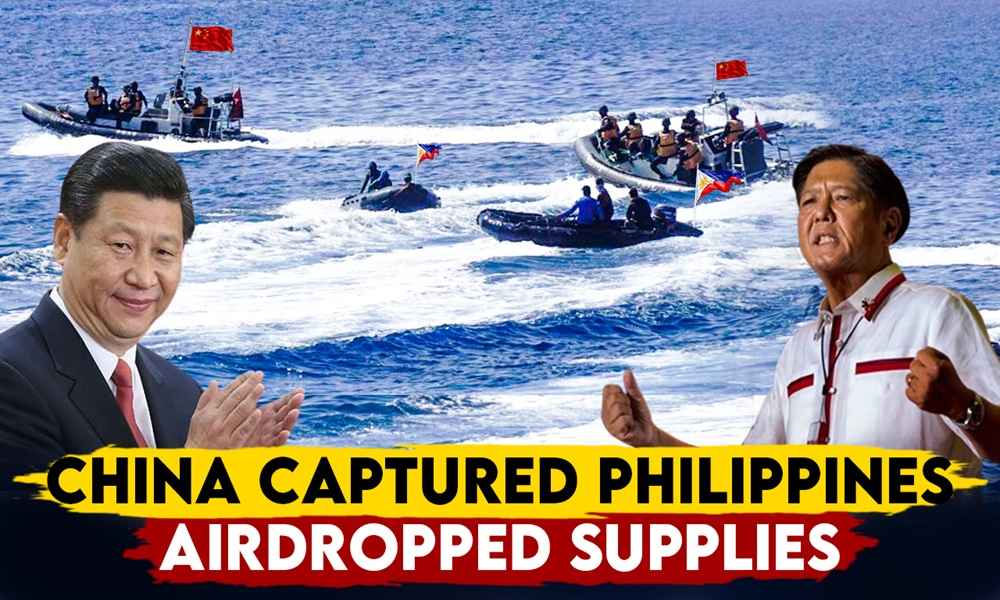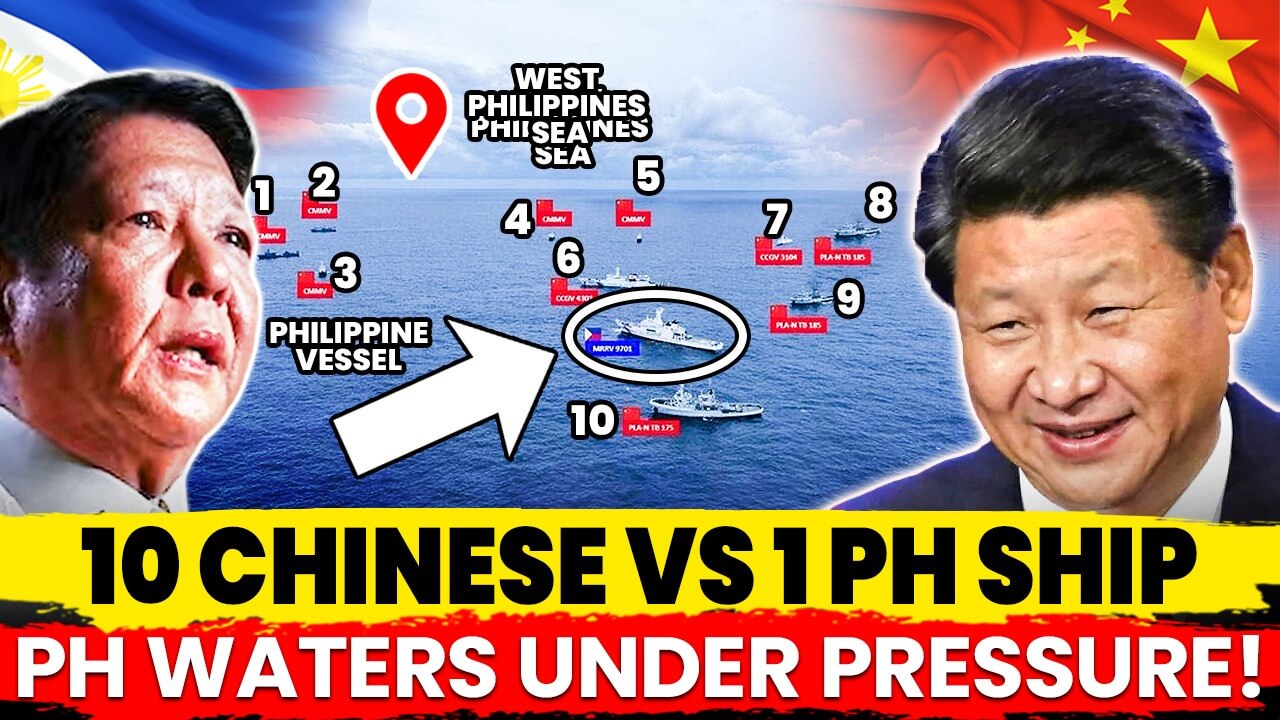In a stark reminder of the ongoing territorial disputes in the South China Sea, the Philippine military reported on Tuesday that the Chinese coast guard seized one of four food packages dropped by a plane for Filipino navy personnel stationed at a contested outpost. General Romeo Brawner disclosed that the Chinese personnel might have suspected the packages contained construction materials to reinforce the deteriorating Philippine navy ship grounded at Second Thomas Shoal. Upon discovering the packages contained only food, including rice and biscuits, the Chinese dumped the items into the sea, Brawner explained.
The dispute over Second Thomas Shoal, known in the Philippines as Ayungin Shoal and in China as Ren’ai Jiao, is a microcosm of the broader territorial contest in the South China Sea, a region where multiple nations lay overlapping claims. The shoal, part of the Spratly Islands, has been a flashpoint for incidents between China and the Philippines since the latter grounded the BRP Sierra Madre, a World War II-era ship, in 1999 to assert its claim.
Chinese officials have not yet commented on Brawner’s statement but have consistently asserted their claim over the shoal, demanding the removal of the Philippine navy ship. Resupply efforts by the Philippines have often led to skirmishes, resulting in damage to supply boats and injuries to personnel. The May 19 incident highlighted the high-stakes nature of these resupply missions. As the Philippine military airdropped four packages at Second Thomas Shoal, a race ensued between Chinese coast guard and Philippine navy personnel to retrieve them. The Filipinos recovered three of the packages, while the Chinese seized one, Brawner said. Despite their efforts, some food was salvaged, but the rice was soaked and inedible.
Legal and International Perspectives
Brawner condemned the seizure as illegal, asserting the Chinese had no right to confiscate supplies meant for Filipino personnel. Video footage released by the Philippine military showed motorboats from both sides dangerously close as they struggled to retrieve the packages, with shouts echoing across the water.
The Philippines maintains that Second Thomas Shoal, less than 200 nautical miles from its coast, lies within its internationally recognized exclusive economic zone (EEZ), supported by a 2016 international arbitration ruling that invalidated China’s extensive claims in the South China Sea. The ruling, issued by the Permanent Court of Arbitration in The Hague, found that China’s claims based on historical rights had no legal basis under the United Nations Convention on the Law of the Sea (UNCLOS). The Philippines frequently cites this ruling to bolster its stance, though Beijing has refused to accept the decision, continuing to assert its dominance in the region.
Rising Hostilities and Diplomatic Tensions
These territorial disputes have strained relations and heightened fears of potential military confrontation, possibly involving the United States, a longstanding treaty ally of the Philippines. Washington, while laying no territorial claims, has warned it is obligated to defend the Philippines if attacked in the South China Sea under the Mutual Defense Treaty of 1951. This treaty underscores the strategic importance of the Philippines in U.S. defense strategy in Asia and its broader goal of maintaining freedom of navigation in international waters.
The United States reaffirmed its commitment to defend the Philippines following recent incidents where Chinese vessels blocked and collided with Filipino ships. The U.S. State Department stated, “The United States stands with our Philippine allies in the face of the People’s Republic of China coast guard and maritime militia’s dangerous and unlawful actions”.
Heightened Regional Tensions
Recently, Philippine diplomats summoned a Chinese Embassy official to protest the collisions, which damaged a Philippine coast guard ship and a navy-operated supply boat. President Ferdinand Marcos Jr. convened an emergency meeting with top military and security officials to address these hostilities. Defense Secretary Gilberto Teodoro condemned China for using “brute force” and distorting facts to conceal its aggression, calling it a blatant violation of international law.
A similar incident was recorded earlier May when Chinese coast guard ships targeted a Philippine supply boat with water cannons, injuring crew members and causing significant damage. The incident drew immediate support from the U.S. and Japan, who condemned China’s aggressive actions near the Second Thomas Shoal, a site of repeated clashes between Chinese and Philippine vessels. Video evidence released by the Philippine military shows Chinese coast guard ships hitting the Unaizah May 4 with high-pressure water cannons, causing the wooden boat to shift dangerously in the sea.
The Philippines plans to raise concerns about Chinese ships’ dangerous maneuvers during upcoming talks with China and ASEAN on a proposed nonaggression pact, known as a “code of conduct,” aimed at preventing major armed conflicts in the South China Sea. These three-day negotiations, hosted by Beijing, underscore the irony of China’s role in facilitating talks while disregarding international law.
Broadening the Conflict
The Chinese diplomat reiterated China’s claim that Philippine vessels had intruded into Chinese territory, urging the Philippines to cease provocations and remove the “illegally grounded” warship, the Sierra Madre. Such confrontational tactics have become the norm in the disputed waters. Similar incidents have been recorded, including the targeting of a Philippine supply boat with water cannons by Chinese coast guard ships.
The longstanding dispute involves multiple claimants, including Vietnam, Malaysia, Taiwan, and Brunei, alongside China and the Philippines. The South China Sea is valued for its fishing stocks and potential oil and gas reserves. Despite the 2016 arbitration ruling, Beijing continues to assert its expansive claims.
Historical Context of the Dispute
The origins of the dispute date back to 1947, when China demarcated its claims in the South China Sea with an eleven-dash line on a map, covering most of the area. After the Communist Party took control in 1949, the line was modified in 1953, reducing it to the current nine-dash line. This demarcation encompasses a significant portion of the South China Sea, an area through which approximately one-third of global maritime trade passes annually.
The legal framework for the dispute was set in 1994 when the 1982 United Nations Convention on the Law of the Sea came into effect. This convention, which defines territorial waters, continental shelves, and exclusive economic zones, was ratified by the Philippines in 1984 and China in 1996, though the United States has never ratified it.
Tensions escalated in 1995 when China took control of the disputed Mischief Reef, constructing structures ostensibly for fishermen. The Philippines protested through ASEAN. In 1997, the Philippine navy blocked Chinese boats from Scarborough Shoal, leading to further protests from China. Over the years, the Philippines detained Chinese fishermen multiple times for alleged illegal fishing in the area.
In 2009, China submitted its nine-dash line map to the United Nations, asserting “indisputable sovereignty” over the islands and adjacent waters in the South China Sea. This claim was met with protests from the Philippines, Vietnam, Malaysia, and Indonesia. In 2011, the Philippines filed a diplomatic protest after Chinese patrol boats harassed a Philippine-chartered ship searching for oil and gas near the Spratly Islands .
Arbitration Ruling and Its Aftermath
The situation intensified in 2012 when China effectively took control of Scarborough Shoal following a standoff between Chinese coast guard ships and a Philippine naval vessel. In 2013, the Philippines brought the dispute to the Permanent Court of Arbitration in The Hague, a move that angered Beijing. The court appointed a panel of international legal experts to hear the case.
The Philippine government summoned China’s top envoy in Manila in February 2014 to protest the firing of a water cannon by a Chinese vessel to drive away Filipino fishermen from Scarborough Shoal. China dismissed the protest, asserting its “indisputable” sovereignty. In December, China issued a position paper arguing that the panel lacked jurisdiction over the case, as it involved issues of sovereignty and boundary definition, which are not covered by the U.N. convention.
In October 2015, the arbitration panel ruled that it had jurisdiction over at least seven of the 15 claims raised by the Philippines, and a hearing on the merits of the claims was held in November without China’s participation. On July 12, 2016, the Permanent Court of Arbitration ruled that China had no legal basis for its claims to much of the South China Sea and had exacerbated the regional dispute through land reclamation and construction of artificial islands, which had damaged coral reefs and the natural state of the disputed areas. The Philippines welcomed the decision, while China outright rejected it.
Military and Strategic Implications
Since the arbitration ruling, tensions in the South China Sea have only worsened. The region has seen an increase in military activities and confrontations, with China continuing to build and militarize artificial islands, installing runways, missile systems, and other military infrastructure. These actions have been perceived as a means for China to establish de facto control over the region, which is crucial not only for its strategic location but also for its abundant natural resources.
The United States and its allies have responded with freedom of navigation operations, sailing warships close to the contested islands to challenge China’s claims and ensure the principle of free passage in international waters. These operations have sometimes led to dangerous encounters between U.S. and Chinese naval vessels.
Diplomatic and Economic Ramifications
The ongoing disputes have significant diplomatic and economic ramifications. Countries like the Philippines have sought to strengthen ties with other regional powers and the United States to counterbalance China’s influence. Under the leadership of President Ferdinand Marcos Jr., the Philippines has realigned more closely with the U.S., contrasting sharply with the previous administration’s attempts to foster closer economic ties with China.
Amid these tensions, China has claimed the existence of an unwritten “gentleman’s agreement” with the Philippines regarding access to islands in the South China Sea. This supposed arrangement, allegedly made during former President Rodrigo Duterte’s visit to Beijing in 2016, purportedly allowed for limited fishing around the disputed islands while restricting military, coast guard, and other official access within a 12-nautical-mile territorial limit. China also asserts that the Philippines committed to removing the BRP Sierra Madre, the navy ship grounded at Second Thomas Shoal, which serves as Manila’s outpost.
Both President Marcos and his predecessor Duterte have denied any agreements compromising Philippine sovereignty. Marcos, who took office in June 2022, dismissed the notion of a secret agreement, stating that any such deal would be rescinded. Duterte emphasized that no formal agreement was made, though he hinted at an informal understanding aimed at maintaining the status quo and avoiding conflict.
China’s aggressive stance has also pushed ASEAN countries to seek a unified approach to handling the South China Sea disputes. However, internal divisions and varying levels of dependence on China have made crafting a cohesive strategy challenging. These complexities underscore the difficulty of achieving a regional consensus on the issue, even as individual nations bolster their defenses and seek alliances to counterbalance China’s growing influence in the region.
Prospects of Regional Stability
As the geopolitical rivalry between the U.S. and China intensifies, the South China Sea remains a critical flashpoint. The strategic importance of this waterway cannot be overstated, as it serves as a major route for international trade and is believed to hold vast reserves of oil and natural gas. The region has become increasingly militarized, with shows of force becoming a common recourse to address tensions. The potential for miscalculation or accidental clashes remains high, with any significant conflict likely to draw in global powers and have far-reaching consequences for regional and global stability.
The international community continues to watch closely, as the potential for conflict in one of the world’s most strategic waterways remains ever-present. As regional and global powers navigate these dangerous waters, the quest for a peaceful resolution seems as elusive as ever, casting a long shadow over the future stability of Asia.



